A) a limestone aquifer that intersects the surface
B) a permeable upper layer with a water table deep below the surface
C) a nonpermeable upper layer with a water table deep below the surface
D) an unconfined aquifer with a water table deep below the surface
Correct Answer

verified
Correct Answer
verified
Multiple Choice
The septic tank in this figure will probably: 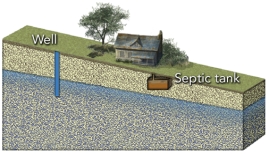
A) contaminate all the water in the well
B) contaminate the part of the well that is lower than the septic tank
C) contaminate the soil at the well but not the groundwater
D) not contaminate the well
Correct Answer

verified
Correct Answer
verified
Multiple Choice
Which of the following is NOT true about groundwater flow?
A) in some igneous groundwater reservoirs,flow is determined by the orientation of fractures
B) excess pumping from wells can cause subsidence and reduction of porosity
C) a decrease in the gradient (slope of the water table) increases the velocity
D) water moves from areas where the water table is highest to areas where it is lowest
Correct Answer

verified
Correct Answer
verified
Multiple Choice
Which of the following features is NOT formed by precipitation of calcite from water?
A) travertine
B) stalagmite
C) stalactite
D) sinkhole
E) flowstone
Correct Answer

verified
Correct Answer
verified
Multiple Choice
Under what conditions is it possible for a material to have both high porosity and low permeability?
A) it is not possible to have both high porosity and low permeability
B) it is possible only if the rock is a sandstone
C) it is possible only if the rock is a granite
D) it is possible if the void spaces are very small or are not well connected
Correct Answer

verified
Correct Answer
verified
Multiple Choice
Which of the following materials probably has the highest porosity?
A) dry,uncompacted clay particles
B) granite with few fractures but very large crystals
C) a limestone that has a few percent open cavities
D) poorly sorted sediment
Correct Answer

verified
Correct Answer
verified
Multiple Choice
Which of the following materials has low to moderate porosity but high permeability?
A) fractured granite
B) compacted clays
C) uncompacted clays
D) well-sorted sediment
Correct Answer

verified
Correct Answer
verified
Multiple Choice
This cross section shows the location of a septic tank with harmful bacteria and 5 wells.Which well is least likely to become contaminated?
A) well A
B) well B
C) well C
D) well D
E) well E![]()
Correct Answer

verified
Correct Answer
verified
Multiple Choice
According to this graph,which shows water balance for the Ogallala aquifer,which of the following statements are true? 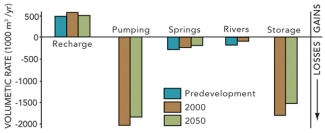
A) More water is taken out of the aquifer than is gained from recharge.
B) Less water is taken out of the aquifer than is gained from recharge.
C) Springs and rivers take out more water than does pumping.
D) As the aquifer dewaters,it expands,increasing the amount of pore space in which to store water.
Correct Answer

verified
Correct Answer
verified
Multiple Choice
Which of the following energy sources drives the hydrologic cycle?
A) internal heat energy
B) river flow
C) wind energy
D) solar energy
E) gravity
Correct Answer

verified
Correct Answer
verified
Multiple Choice
Which of the following would be most useful in investigating groundwater contamination?
A) records of how much material the company may have spilled
B) records of health problems,like leukemia,of people living in the area
C) a map showing contours of the water table and of contamination levels
D) a geologic map
Correct Answer

verified
Correct Answer
verified
Multiple Choice
In which areas on the accompanying figure is condensation occurring? 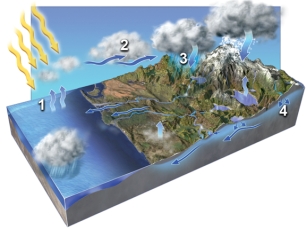
A) 1 and 2
B) 2 and 3
C) 3 and 4
D) 1 and 3
E) 2 and 4
Correct Answer

verified
Correct Answer
verified
Multiple Choice
Which of the following is true about how contamination moves in groundwater?
A) contamination moves up the slope of groundwater
B) contamination moves opposite to the direction of groundwater flow
C) contamination introduced into the ground does not move
D) contamination spreads out as it moves,forming a widening plume
Correct Answer

verified
Correct Answer
verified
Multiple Choice
What is a possible way to decrease permeability?
A) fracture a rock
B) compact sediment
C) have groundwater dissolve cement between the grains
D) all of these
E) none of these
Correct Answer

verified
Correct Answer
verified
Multiple Choice
Which of the following materials probably has the highest porosity?
A) poorly sorted sediment
B) sediment composed only of rounded cobbles that rest directly on one another
C) a mixture of sand,silt,and clay
D) a coarse-grained granite
Correct Answer

verified
Correct Answer
verified
Multiple Choice
Which of the following factors least influences infiltration capacity?
A) slope of the land
B) nature of the vegetative cover
C) rainfall intensity
D) prior wetted condition of the soil
E) ambient temperature
Correct Answer

verified
Correct Answer
verified
Multiple Choice
Which of the following would NOT help you determine that an upper layer of unconsolidated sediments became thicker toward a basin?
A) drilling
B) gravity studies
C) measurements of discharge in surface streams
D) an understanding of the subsurface geology of the area
E) a correctly drawn geologic cross section
Correct Answer

verified
Correct Answer
verified
Multiple Choice
This figure shows a new well that will pump out groundwater faster than it can be replaced.What will the water table look like after pumping? 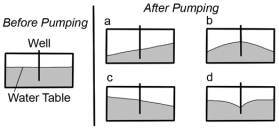
A) A
B) B
C) C
D) D
Correct Answer

verified
Correct Answer
verified
Multiple Choice
What is the main problem that has developed in the Ogallala aquifer?
A) it has become contaminated with radioactive waste from the Chernobyl accident
B) precipitation is heavier to the east,causing tilting of the entire formation
C) overpumping may cause southern parts of the aquifer to go dry in the next 100 years
D) none of these
Correct Answer

verified
Correct Answer
verified
Multiple Choice
Which of these numbered features contains the least amount of Earth's water? 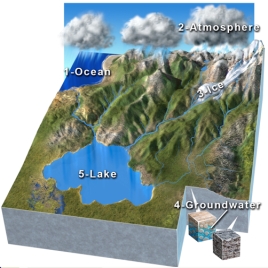
A) 1-ocean
B) 2-atmosphere
C) 3-glaciers and ice sheets
D) 4-groundwater
E) 5-lakes
Correct Answer

verified
Correct Answer
verified
Showing 21 - 40 of 129
Related Exams